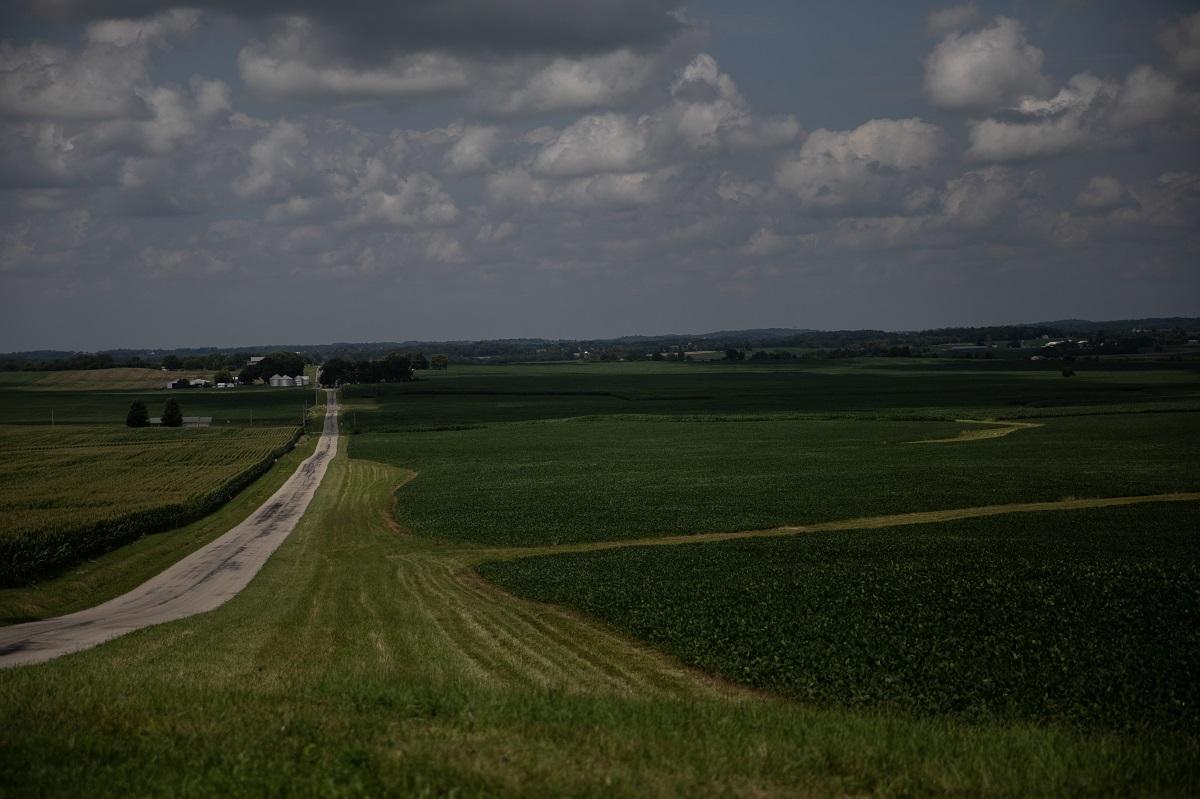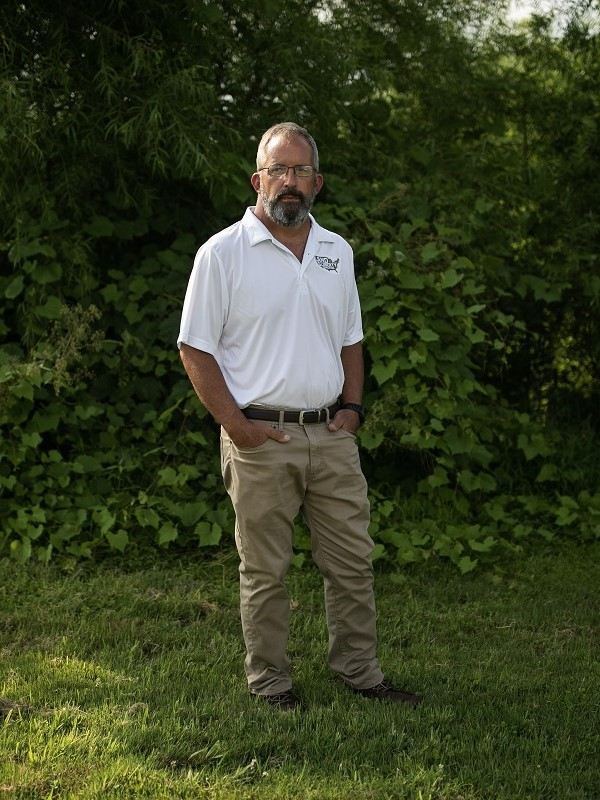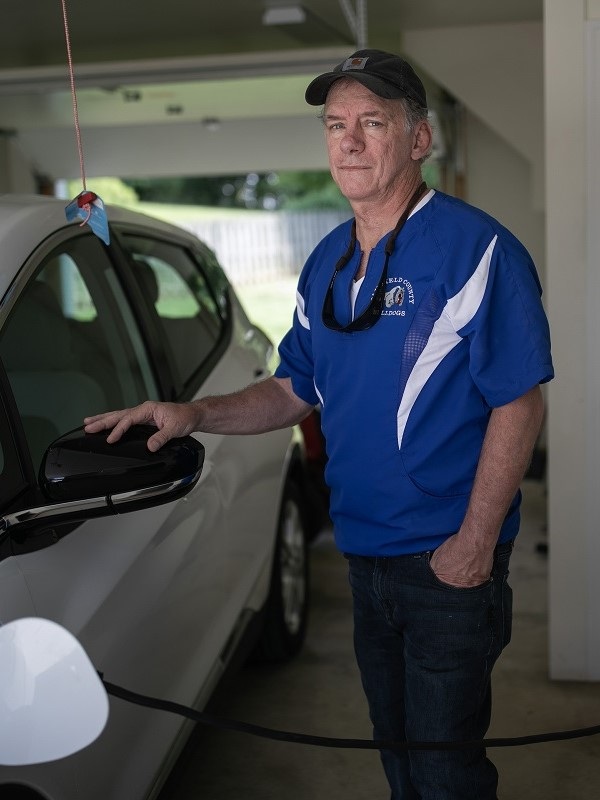
Farmland that could be developed into a solar field in Amanda, Ohio.
17:13 JST, July 24, 2023
FAIRFIELD, Ohio – Tony Zartman has listened to opponents of a proposed solar farm claim that runoff from the panels would contaminate their drinking water. He’s heard that wind turbines make cellphone service impossible. And he’s been told that solar farms would be overrun by rats that would torment neighbors.

Tony Zartman at Buckeye Lake State Park in Ohio.
One recent Tuesday morning, Zartman stood a few feet away as the three Republican commissioners of Fairfield County weighed the fate of a proposal to build a solar farm on central Ohio farmland worth more than $250 million. A Republican, Zartman had approved a major renewable energy project while commissioner of Paulding County, and for the past year, he has crisscrossed the state urging others to do the same. The Fairfield commissioners should put politics aside, Zartman urged, and approve the proposed site. Jobs would come. The money the company was providing for the project was real. Tax revenue would jump.
“We have new parks; the school systems are flourishing with all the additional revenue; the roads are in the best condition they’ve been in,” said Zartman, 55, who has traveled to more than 40 counties across the state spreading this message. “I tell them, ‘I am a die-hard conservative, but I support renewables because they’ve just been amazing for us financially.'”
For all Zartman’s evangelism, his arguments do not always carry the day in the red heart of Ohio. Like similar fights throughout conservative parts of the United States, the debate in Fairfield County reflects one of the central ironies of President Biden’s signature legislation, last year’s Inflation Reduction Act: Although it was drafted and passed exclusively by Democrats in Washington, the fate of the law will hinge in large part on the decisions of state and local Republican officials.
The idea behind the law, and its hundreds of billions of dollars in expanded clean-energy tax credits, was to change both the economics and the politics that have held green industry back. Rather than pursue a carbon tax administered by the federal government or other policies some on the left have pushed, the Biden administration is seeding the money for a new renewable energy sector that would make cleaner options a better bet financially than burning fossil fuels, regardless of one’s position on climate change. The hope was that government subsidies would unleash a tidal wave of investment to shatter local opposition and break the nation’s dependence on fossil fuel energy, particularly as the cost of renewable energy plummets.
But it won’t succeed without cooperation from some of Biden’s political adversaries. Huge swaths of this new green energy production are being proposed for rural states, where land is cheaper than on the urbanized coasts: Ohio and Texas for expansive new solar arrays; massive wind installations in the open plains of Oklahoma and Nebraska; a new hub for producing batteries for electric vehicles in the Southeast, centered in Georgia and South Carolina. The law includes incentives to make it particularly attractive for clean energy firms to invest in former fossil-fuel-producing communities, and clean energy firms often look for workforces that are not unionized. These factors also push investment to GOP-held states.
This emphasis on rural areas puts local GOP officials in the position of overseeing massive amounts of development funded by Biden’s law. Of the approximately $70 billion in new clean energy investment dollars announced since the climate law passed, roughly $51 billion – or 70 percent – is in counties won by Donald Trump in the 2020 presidential election, according to Jack Conness, a policy analyst at Energy Innovation: Policy and Technology, a nonpartisan think tank.
The legislation is projected to reduce carbon emissions by about 780 million tons per year by 2030. But that number could fall by as much as 260 million tons per year, or roughly 30 percent, if the pace of solar and wind deployment slows amid local opposition, according to projections by the REPEAT Project at Princeton University.
“Where the rubber hits the road for this bill will be in factory communities and rural communities that can host wind and solar, and that will be outside urban Democratic districts,” said Jesse Jenkins, a Princeton professor and one of the report’s authors. “For the first time in decades, the government is bringing transformative opportunities to communities that have been left behind. But if they see these projects as a burden instead of a boon, it will dramatically undermine the impact of the Inflation Reduction Act.”
The funding is splintering a Republican Party that remains skeptical about renewable energy – and hostile to Biden.

People hold “No Solar on Prime Farmland” signs at a zoning meeting in Millersport, Ohio, on July 19.
Georgia Gov. Brian Kemp and U.S. Sen. Lindsey O. Graham (R-S.C.) are among the GOP officials throwing their weight behind the electric vehicle battery sector. But other Republicans, like conservatives in the Texas Capitol, are going in the opposite direction, pushing to repeal subsidies for solar and wind projects even though renewable energy has proved essential for the state’s electrical grid. House Speaker Kevin McCarthy (R-Calif.) and senior Republicans on Capitol Hill leadership have pushed for repealing the renewable energy credits in the Inflation Reduction Act – though resistance from members of his caucus whose districts are already benefiting from the credits led him to drop some of those demands.
As the number of proposed renewable energy projects soars, so has the backlash. State and local lawmakers have blocked 547 solar and wind projects this year already – a nearly 15 percent increase from last year’s total, even though the year is only half over, and a nearly 70 percent jump since 2021, according to the Renewable Rejection Database, which tracks local governments’ approvals of renewables.
While much of the opposition is ideologically motivated, some nearby residents also object to new industrial uses in their rural communities. Solar panel farms can stretch for hundreds or thousands of acres on previously green pastures. Construction can affect the tilling farms need for drainage, while also adding traffic and noise. That can provoke opposition in liberal states as well as conservative ones, with some officials in New Jersey, New York and elsewhere also balking at large new energy projects.
“When your strategy for decarbonization is to massively industrialize landscapes all over the country, there’s going to be lots of resistance to that,” said Ted Nordhaus, executive director of the Breakthrough Institute, a California-based think tank that supports reform to expedite renewable energy projects. “It’s not all milk and honey for the local communities – there’s real impacts here.”
“If you live in San Francisco or Washington or New York City, you might go: ‘Whatever, there’s nobody there.’ But there are actually people who live there, and a lot of them are not wild about this,” Nordhaus said.
Across Ohio, debates are breaking out everywhere from Walnut Township to the statehouse in Columbus about whether, and how, to get behind clean energy, as officials are pulled between the allure of economic development and the opposition of local activists.
For some Ohioans, the financial incentives are enough. The state has seen the fifth-biggest investment in renewable energy projects – $6 billion – since passage of the Inflation Reduction Act, according to Conness. Only Texas and California are projected to see their solar sectors grow more quickly over the next four years. Conservative business executives from Cincinnati to Cleveland stressed that they may not like Biden, or believe in his approach to subsidizing clean energy, but they see the potential to make money.
“I don’t really look at this from a ‘let’s go out there and hug trees’ perspective,” said Russ Bates, who served as a senior executive in the fossil fuel industry before starting his own consulting firm in the Cleveland area for industrial solar installations in 2021. “But from an economic perspective, it is making so much more sense to do this.”
Yet a growing backlash in rural Ohio – fueled by ideology, but not limited to it – could limit the sector’s growth. Ohio officials have rejected more than 400 proposed renewable projects, more than any other state, according to the Renewable Rejection Database. Since 2021, developers have either withdrawn or seen rejected more than 1.2 gigawatts of solar projects in Ohio, enough to power roughly 120,000 homes. That is roughly one-seventh of the entire planned increase in solar production in the state between 2023 and 2028, according to Matthew Sahd, an analyst at Wood Mackenzie, a research and consulting firm. Sahd cautioned that these numbers are expected to grow, with anecdotal evidence suggesting a broad increase in resistance to renewable projects in many parts of the state.
Ohio’s state government has made renewable proposals easier for local officials to block. It substantially curtailed new wind development with a law that restricted how the projects could be constructed. At least 10 of Ohio’s 88 counties have enacted bans on large-scale wind and solar projects, with at least six more counties considering similar measures, according to a Washington Post tally.
And although capacity will expand because of projects already in the pipeline, the number of new utility-scale solar proposals plummeted from 15 in 2021 to two after passage of the law giving local lawmakers more sway, according to Marilla Smith and Gilbert Michaud, analysts at Loyola University Chicago.
In Fairfield County, hundreds of activists have worked to kill attempts to build solar projects in central Ohio. In Amanda Township, on the western side of the county, solar developers snapped up more than 1,000 acres of farmland, although no developer has come forward with a proposal. In Walnut Township, in the northeast side of the county, the solar firm EFG Renewables has proposed a solar field on more than 3,000 acres of farmland.
Much of the opposition that has emerged is nonideological. On a recent Tuesday evening, Jerry Starner, 61, pointed at the green rows of corn stalks to the north of his farmstead, dappled with pink rays from the setting sun. He and his wife restored the 1889 farmstead they bought 32 years ago, and he had long planned on retiring there. Although his property is too small to receive a bid from the solar company, his home would soon be surrounded on all sides by solar panels – with arrays going up to the north, east, west and south.
“All that corn you see? That would be solar panels,” Starner said, as his dogs, Jovi and Nellie, roved the grass. “It consumes me. This has completely upended my life. It’ll be like driving home to a prison.”
Others in the town characterize the struggle as part of a broader national fight against faceless corporations and liberals. During a meeting of the town of Amanda, Austin Reid, 29, one of the trustees, shook his head as he wondered why the industrial solar panels could not be placed in cities on the coasts, if that’s how their residents wanted to get their energy supply.
“This administration is paying for this – the last administration did not,” he said.
At a meeting the next night in Walnut, Bill Yates, one of the town’s trustees, told a representative for EDF Renewables that the plan was only moving forward because it was receiving federal subsidies from Biden’s plan.
“If you were doing this with your own money, you would not be doing it,” Yates said. “You’re doing it with taxpayer money.”
The county commissioners who will decide the projects’ fate are, for now, careful to avoid picking a side.

Steve Davis charges his Chevy Bolt in Lancaster, Ohio, on July 20.
Steve Davis, one of the commissioners, said he attended a meeting at a schoolhouse in late June where more than 200 opponents of the solar project showed up in matching red shirts. They expressed their fears of a collapse in home prices, retirement plans upended and soil contamination from chemicals that would “leech” from broken parts. (Several experts said there was no evidence runoff from solar panels ruins farmland soil.) Many were lifelong neighbors.
But Davis seems skeptical of a ban. Although a lifelong Republican and supporter of Donald Trump, he recently bought a Chevy Bolt and installed solar panels on his roof, which he says has saved him money on his electric bill and on gas. He is skeptical that the solar farm itself will create that many jobs, but points out that county officials have spoken with Intel, Facebook and Google – companies that may want to locate data centers near renewable energy sources.
“I’m not trying to save the world. I’m not trying to reduce my carbon footprint,” Davis said in an interview last week in his office, after about a dozen protesters showed up yet again to a county commission meeting. “I’m really just trying to reduce my expense footprint.”
"News Services" POPULAR ARTICLE
-

American Playwright Jeremy O. Harris Arrested in Japan on Alleged Drug Smuggling
-

Japan’s Nikkei Stock Average as JGB Yields, Yen Rise on Rate-Hike Bets
-

Japan’s Nikkei Stock Average Licks Wounds after Selloff Sparked by BOJ Hike Bets (UPDATE 1)
-

Japan’s Nikkei Stock Average Buoyed by Stable Yen; SoftBank’s Slide Caps Gains (UPDATE 1)
-

Japanese Bond Yields Zoom, Stocks Slide as Rate Hike Looms
JN ACCESS RANKING
-

Tokyo Economic Security Forum to Hold Inaugural Meeting Amid Tense Global Environment
-

Keidanren Chairman Yoshinobu Tsutsui Visits Kashiwazaki-Kariwa Nuclear Power Plant; Inspects New Emergency Safety System
-

Imports of Rare Earths from China Facing Delays, May Be Caused by Deterioration of Japan-China Relations
-

University of Tokyo Professor Discusses Japanese Economic Security in Interview Ahead of Forum
-

Japan Pulls out of Vietnam Nuclear Project, Complicating Hanoi’s Power Plans
























